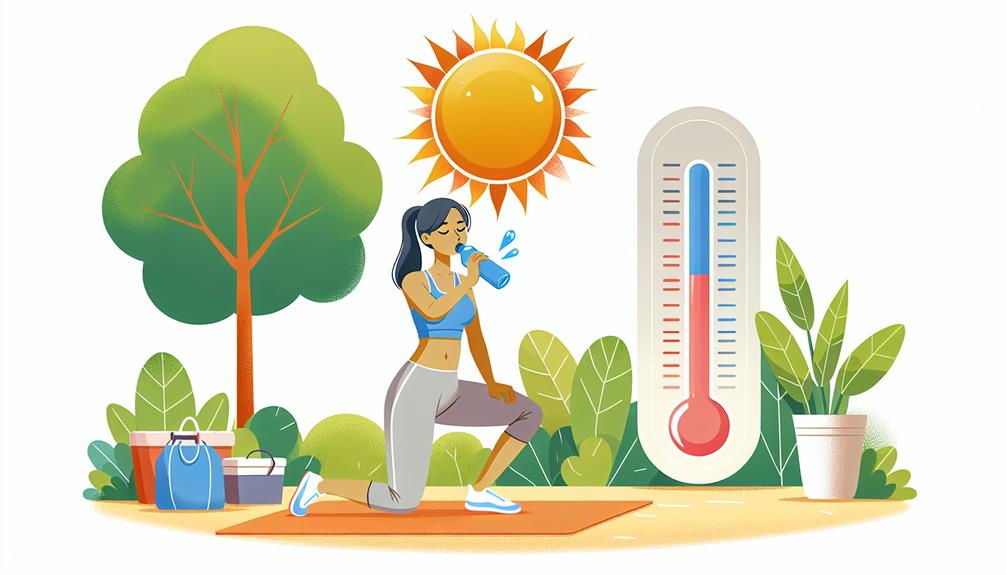Feeling like a human sauna might not be your idea of a good time, but hold up before you crank the AC on your workout.
Training in hot environments can actually offer you some surprising benefits that might make you rethink your cool and comfy gym routine. From improved cardiovascular endurance to mental toughness enhancement, the heat might just be your new fitness ally.
But before you start sweating it out, there are crucial precautions you need to consider for your safety and performance.
Key Takeaways
- Enhanced cardiovascular endurance and performance
- Increased calorie burn and metabolic rate
- Mental toughness development through focus and conditioning
- Precautions include hydration, gradual exposure, proper clothing, and scheduling
Benefits of Training in Heat
Training in hot environments offers numerous advantages for athletes seeking to enhance their performance and acclimate to challenging conditions. When it comes to hydration strategies, training in the heat can significantly improve an athlete's ability to regulate body temperature and maintain optimal fluid balance. By implementing proper hydration techniques, such as consuming electrolyte-rich fluids and monitoring sweat loss, athletes can enhance their endurance and overall performance during intense workouts in hot conditions.
Moreover, training in the heat can lead to performance adaptations that are beneficial for athletes. The body's physiological responses to exercising in a hot environment include increased plasma volume, improved sweat rate, and enhanced thermoregulatory mechanisms. These adaptations can translate to improved performance in various sports, especially those that take place in hot climates. By exposing yourself to these conditions regularly and incorporating appropriate hydration strategies, you can better prepare your body to excel in challenging environments and optimize your athletic potential.
Improved Cardiovascular Endurance
Developing improved cardiovascular endurance is a key factor in enhancing athletic performance and overall fitness levels. When training in hot environments, the cardiovascular system is put under increased stress, leading to adaptations that can significantly improve performance. Endurance exercises like running, cycling, or swimming in the heat can help boost your heart's efficiency, increase stroke volume, and enhance oxygen delivery to working muscles. This improvement in cardiovascular endurance allows you to exercise at higher intensities for longer durations, leading to better overall athletic performance.
Hydration strategies play a crucial role in optimizing cardiovascular endurance during training in hot environments. Proper hydration helps maintain blood volume, which is essential for cardiovascular function. Dehydration can strain the heart and reduce performance levels. It's vital to drink water regularly before, during, and after exercise in the heat to prevent dehydration and support cardiovascular health. By incorporating effective hydration practices into your training routine, you can enhance your cardiovascular endurance and overall athletic performance.
Increased Calorie Burn

Optimizing your calorie burn becomes essential when training in hot environments, as the increased heat stress can elevate your metabolic rate and energy expenditure. This phenomenon is particularly advantageous for individuals aiming to shed extra pounds or improve their overall fitness levels. Heat acclimation, which occurs when your body adapts to exercising in high temperatures, plays a significant role in enhancing calorie torching during workouts. When you subject yourself to training in hot conditions, your body's response is to cool itself down by increasing blood flow to the skin and sweating more profusely. These mechanisms require additional energy, resulting in a higher calorie burn compared to exercising in cooler environments.
To illustrate the impact of training in hot environments on calorie burn, the table below outlines the estimated calorie expenditure for a 30-minute moderate-intensity workout in both hot and temperate conditions:
| Hot Environment | Temperate Environment | |
|---|---|---|
| Calories | 300 | 200 |
| Difference | +100 | – |
Mental Toughness Enhancement
Enhancing mental toughness in hot environments requires deliberate focus and strategic mental conditioning to withstand the challenges posed by the demanding conditions. Mental focus is crucial in maintaining performance levels as the heat can be mentally draining. To improve mental toughness, resilience building techniques such as visualization, positive self-talk, and goal setting can be beneficial.
Visualization involves mentally rehearsing the training or competition in a hot environment, preparing the mind for the conditions it will face. Positive self-talk helps in staying motivated and maintaining a strong mindset despite the discomfort. Setting specific, achievable goals can provide a sense of direction and purpose, aiding in overcoming obstacles during training.
Precautions for Hot Environment Training

To ensure safe and effective training in hot environments, it is essential to implement specific precautions that mitigate the risks associated with heat exposure and exertion. Dehydration prevention and heat exhaustion are critical considerations when engaging in physical activities in high temperatures. Here are some key precautions to take:
| Precaution | Description |
|---|---|
| Hydration | Drink plenty of water before, during, and after training to prevent dehydration. |
| Acclimatization | Gradually expose yourself to the heat to allow your body to adapt over time. |
| Clothing | Wear lightweight, light-colored, and breathable clothing to help regulate body temperature. |
| Time of Training | Schedule workouts during cooler parts of the day to reduce the risk of heat-related illnesses. |
| Rest and Shade | Take frequent breaks in shaded areas to rest and cool down to prevent heat exhaustion. |
Frequently Asked Questions
Can Training in Hot Environments Lead to Dehydration, and How Can It Be Prevented?
Training in hot environments can lead to dehydration. To prevent this, focus on hydrating adequately before, during, and after your session. Utilize hydration strategies like consuming electrolyte-rich fluids and monitoring your body's fluid levels closely.
Is There a Limit to How Much Time Should Be Spent Training in the Heat to Avoid Negative Health Effects?
To avoid negative health effects, it's crucial to set limitations on your time spent training in the heat. Safety precautions like staying hydrated, taking breaks, and listening to your body are essential for preventing heat-related issues during workouts.
Are There Specific Types of Clothing or Gear That Should Be Worn When Training in Hot Environments?
Wearing cooling garments during hot weather workouts can help regulate body temperature and improve performance. Hydration strategies are crucial too. Be proactive in choosing breathable, moisture-wicking fabrics to stay comfortable and safe during intense training sessions.
How Does Training in Hot Environments Affect Muscle Recovery and Growth?
When training in hot environments, heat stress can impact muscle recovery and growth. Increased temperature can alter protein synthesis rates, potentially affecting adaptation. Adequate hydration, recovery strategies, and monitoring are crucial to optimize muscle responses and prevent negative effects on growth.
Are There Any Specific Dietary Recommendations for Individuals Training in Hot Environments to Optimize Performance and Recovery?
To optimize your performance and recovery in hot environments, focus on optimal hydration and maintaining a nutritional balance. These factors play a crucial role in supporting your body's needs during intense training sessions and aiding in post-workout recovery.
Conclusion
In conclusion, training in hot environments can be a powerful tool to enhance your fitness levels, but it comes with its own set of precautions. Like a double-edged sword, the benefits of improved cardiovascular endurance, increased calorie burn, and mental toughness enhancement must be balanced with proper hydration, gradual acclimatization, and awareness of heat-related risks.
Approach hot environment training with caution, respect the heat, and reap the rewards of your hard work. Stay safe, stay strong.













